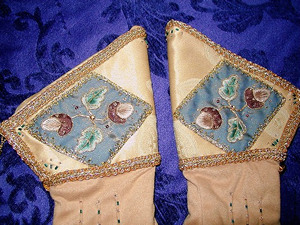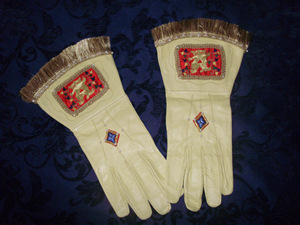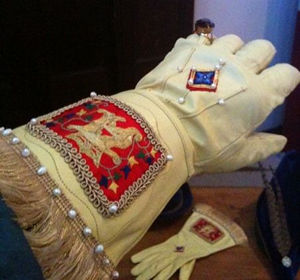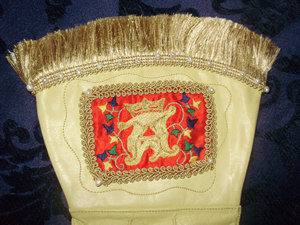
Historical Hats, Costumes & Accessories |
||
|
Home Crown Hood and Liripipe Man´s Cap Chaperon Torque Bycocket Crispinette Tressour Crispinette Nebule Templars Cross Tree Headdress Heart Shaped Hennin Attor de Gibet Jewelled Coif Hennin Flowerpot Hennin Halo Bonnet Reticulated Caul Flemish Hood Early Gable Headdress Tudor/Elizabethan Pouch Gloves Wedding Dresses Specialist Commissions Kats Kittens Authentic Effigy Based Headwear Miscellaneous Contact Links |
The Glove 600 - 146 B.C. to Present Day
In other countries across Europe there are several names for the glove: -
The Franks used the word "Wantus" for the glove and they were worn by the wealthy. They were made of fine skins with the fur on the inside and ornamented outside with gold and set with jewels. They resembled our modern day Mittens (a bag with a separate piece for the thumb). By the time of William I, William II and Henry I they were still the bag shaped gloves called the "Moufle." It was only in the C.12th that separate fingers were introduced. Henry II wears this early version on his tomb effigy in Fontevraud. The poor still wore the "Bag" glove. Most early fingered gloves were loose at the wrist so the glove could be put on easily. They were made of various materials, animal skins, cotton, silk, velvet and knitted materials were favoured. Sometimes the edge of the cuff was decorated in gold work and pearls with an ornamental plaque on the back of the hand. Rings were also worn on the outside of the glove. In the C.13th the cuff became deeper sometimes over 4 inches deep. It lost its circular cut and became more pointed. Most were heavily embroidered and an example can be seen in a painting in Westminster Abbey of Edward I. During the C.14th and C.15th gloves were in common use by all, including the clergy, but had many differences. These were sometimes a longer and wider cuff (a gauntlet), an ornamental drop on the cuff (a fancy button or tassel) and buttoning from the wrist to the cuff. There was also zigzag stitching on the seams as well as slashing on the fingers of leather gloves to show costly rings worn underneath. The longer cuff was also cut and slashed as a form of decoration as was back of the hand. A thicker form of leather glove was used for hunting and hawking. Middle and lower classes had quality gloves according to their station. Labourers and masons had simpler serviceable forms of gloves.
Headdress Design © 2001 - 2011|Site Design © 2005, 2006, 2007, 2008, 2009, 2010, 2011, 2012, 2013 All Items produced by Kats Hats © are subject to full copyright and may not be reproduced under any circumstances. Individuals have my permission to print single copies of the pictures or texts on this website for research for non-commercial purposes and private study provided Kats Hats © name, the copyright notice and this permission notice are preserved on all copies. Linking to this site is allowed without permission. For any other use please contact me. | |
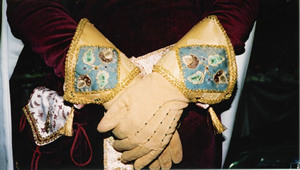 During Greek times the first Glove was discovered. An excerpt in
Homer´s Odyssey gives details of peasants clothing including the
first hand covering. They were "Pieces of hide tied or laced round the
forearm, wrist and hand, leaving the fingers free with a hole for the
thumb." Then during Roman times came the Latin "Manica."
This had fingers attached.
During Greek times the first Glove was discovered. An excerpt in
Homer´s Odyssey gives details of peasants clothing including the
first hand covering. They were "Pieces of hide tied or laced round the
forearm, wrist and hand, leaving the fingers free with a hole for the
thumb." Then during Roman times came the Latin "Manica."
This had fingers attached.
